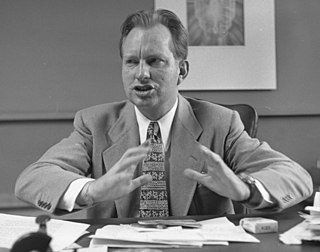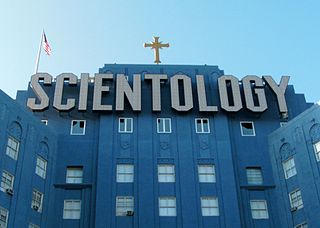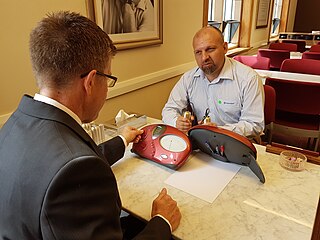Related Research Articles

Dianetics is a set of ideas and practices invented in 1950 by science fiction writer L. Ron Hubbard regarding the human mind. Dianetics was originally conceived as a form of psychological treatment, but was rejected by the psychological and medical establishments as pseudoscientific. Dianetics was the precursor to Scientology and has since been incorporated into it.

Hypnosis is a human condition involving focused attention, reduced peripheral awareness, and an enhanced capacity to respond to suggestion.

Lafayette Ronald Hubbard was an American author and the founder of Scientology. A prolific writer of pulp science fiction and fantasy novels in his early career, in 1950 he authored Dianetics: The Modern Science of Mental Health and established organizations to promote and practice Dianetics techniques. Hubbard created Scientology in 1952 after losing the intellectual rights to his literature on Dianetics in bankruptcy. He would lead the Church of Scientology, variously described as a cult, a new religious movement, or a business, until his death in 1986.
Suggestibility is the quality of being inclined to accept and act on the suggestions of others. One may fill in gaps in certain memories with false information given by another when recalling a scenario or moment. Suggestibility uses cues to distort recollection: when the subject has been persistently told something about a past event, his or her memory of the event conforms to the repeated message.

Free Zone, Freezone, and Independent Scientology are umbrella terms for the groups, organizations, and individuals who practice Scientology beliefs and practices independently of the Church of Scientology (COS). Such practitioners range from those who closely adhere to the original teachings of Scientology's founder L. Ron Hubbard, to those who have adapted practices far from COS beliefs and practices.

The Church of Scientology maintains a wide variety of beliefs and practices. The core belief holds that a human is an immortal, spiritual being (thetan) that is resident in a physical body. The thetan has had innumerable past lives, some of which, preceding the thetan's arrival on Earth, were lived in extraterrestrial cultures. Based on case studies at advanced levels, it is predicted that any Scientologist undergoing auditing will eventually come across and recount a common series of past-life events.

The E-Meter is an electronic device used in Scientology that allegedly "registers emotional reactions". After claims by L. Ron Hubbard that the procedures of auditing, which used the E-Meter, could help heal diseases, the E-Meter became the subject of litigation. Since then, the Church of Scientology publishes disclaimers declaring that the E-Meter "by itself does nothing", is incapable of improving health, and is used solely for spiritual purposes.

Auditing, also known as processing, is the core practice of Scientology. Scientologists believe that the role of auditing is to improve a person's abilities and to reduce or eliminate their neuroses. The Scientologist is asked questions about past events while holding two tin cans attached to an electrical resistance meter (galvanometer) with a dial. The term "auditing" was coined by L. Ron Hubbard in his 1950 book Dianetics: The Modern Science of Mental Health which describes the process. Auditing uses techniques from hypnosis that are intended to create dependency and obedience in the subject.
Dianetics: The Modern Science of Mental Health, sometimes abbreviated as DMSMH, is a book by L. Ron Hubbard about Dianetics, a pseudoscientific system that he claimed to have developed from a combination of personal experience, basic principles of Eastern philosophy and the work of Sigmund Freud. The book is considered part of Scientology's canon. It is colloquially referred to by Scientologists as Book One. The book launched the movement, which later defined itself as a religion, in 1950. As of 2013, New Era Publications, the international publishing company of Hubbard's works, sells the book in English and in 50 other languages.
In Dianetics and Scientology, Clear is a status afforded to followers by the Scientology organization, or by other Scientologists, after they complete certain activities. It is one of the major ostensible "states" practitioners strive to reach on their way up what the Scientologists call the Bridge to Total Freedom. Scientology followers are given the status of Clear when a person is deemed to be free of the influence of engrams – supposed unwanted emotions or painful traumas which Scientology claims are not readily available to the conscious mind. Scientologists believe that human beings accumulate anxieties, psychosomatic illnesses, and aberration due to receiving engrams throughout their current or past lives, and that by applying Dianetics, every single person can obtain the status of Clear.

History of Dianetics and Scientology begins around 1950. During the late 1940s, L. Ron Hubbard began developing a mental therapy system which he called Dianetics. Hubbard had tried to interest the medical profession in his techniques, including the Gerontological Society, the Journal of the American Medical Association, and the American Journal of Psychiatry, but his work was rejected for not containing sufficient evidence of efficacy to be acceptable.
Volney G. Mathison, also known by the pseudonym Dex Volney, was an American chiropractor, writer, and inventor of the first E-meter used by the Church of Scientology.

Scientology: A History of Man is a book by L. Ron Hubbard, first published in 1952 under the title What to Audit by the Scientific Press of Phoenix. According to the author, it provides "a coldblooded and factual account of your last sixty trillion years." It has gone through many editions since its first publication and is a key text of the Church of Scientology. The book has been ridiculed by critics of Scientology for its unusual writing style and pseudoscientific claims; it has been described as "a slim pretense at scientific method ... blended with a strange amalgam of psychotherapy, mysticism and pure science fiction; mainly the latter."

This bibliography of Scientology includes Scientology and Dianetics-related books authored by L. Ron Hubbard and those produced by the Church of Scientology and its related organizations. Books bearing L. Ron Hubbard's name are considered texts of Scientology's canon.
The amount of material on Dianetics and Scientology is extensive, to say the least. This material is composed of books by L. Ron Hubbard ; compilations of his works; taped lectures; auditor training materials ; course packages; booklets; a large number of magazines and annuals; and video recordings of the major annual events.

The Bridge to Total Freedom, also known as the Classification, Gradation and Awareness Chart, is Scientology's primary action plan and road map to guide a person through the sequential steps to attain Scientology's concept of spiritual freedom. Displayed in every Scientology organization as an enormous poster using red ink, the comprehensive chart contains almost every service available within Scientology. All steps on the Bridge cost money.

The relationship between Scientology and religious groups is very complex. While Scientology claims that it is fully compatible with all existing major world religions and that it does not conflict with them or their religious practices, there are significant contradictions between Scientology and most religions, especially the major monotheistic religions. Members are not allowed to engage in other similar mental therapies or procedures, religious or otherwise.
The training routines (TR) are training exercises or drills used in the Church of Scientology as well as affiliated programs Narconon, Criminon and WISE. The church describes them as a way of learning to communicate effectively and to control situations. Some critics and former Scientologists claim the training routines have a strong hypnotic effect, causing hallucinations and an out-of-body experience known as exteriorization.
References
- 1 2 3 4 5 6 7 8 Hassan, Steven A.; Scheflin, Alan W. (2024). "Understanding the Dark Side of Hypnosis as a Form of Undue Influence Exerted in Authoritarian Cults: Implications for Practice, Policy, and Education". In Linden, Julie H.; De Benedittis, Giuseppe; Sugarman, Laurence I.; Varga, Katalin (eds.). The Routledge International Handbook of Clinical Hypnosis. Abingdon/New York: Routledge. pp. 755–772. ISBN 978-1-032-31140-1.
- ↑ Robinson, Jill (1997-11-11). "L. Ron Hubbard". Secret Lives. A&E.
- ↑ Hubbard, L. Ron (October 1958). The Story of Dianetics and Scientology, Lecture 18 (Speech).
- ↑ Hubbard, What is Scientology?, 1998 softcover edition, pg. 529.
- ↑ Petsche, Johanna J.M. (2017). "Scientology in Paul Thomas Anderson's The Master". In Lewis, James R.; Hellesøy, Kjersti (eds.). Handbook of Scientology. Leiden/Boston: Brill Publishers. pp. 360–380. ISBN 9789004328716.
- ↑ Müller, Tilo (2010). Dianetik und Scientology in ihrem Anspruch als Wissenschaft. GRIN Verlag. p. 32. ISBN 978-3-640-58010-1.
Mathison stated: "I decry the doings of trivial fakers, such as scientologists and the like, who glibly denounce hypnosis and then try covertly to use it in their phony systems"
- ↑ Wakefield, Margery (2009). Understanding Scientology: The Demon Cult. Lulu.com. p. Chapter 6. ISBN 9780557109265.
- ↑ כהן, אוריאן (February 4, 2010). מסדנת המודעות לאברבנאל: הסכנות שבהיפנוזה [From the Awareness Seminar to Abrabanel: The Dangers of Hypnosis]. Ynet (in Hebrew). Israel.
לפי ד"ר אביב, הסיינטולוגים משתמשים בטכניקות היפנוטיות ברורות: "הם משחזרים זיכרונות מוקדמים, בדרך כלל של טראומות, כאשר בחלק מהמקרים זהו זיכרון מומצא .(memory false) כאשר מטופל 'נזכר' באירוע מומצא שכזה באמצעות תהליך היפנוטי - האירוע עלול להפוך להיות אמיתי עבורו."
[According to Dr. Aviv, the Scientologists use clear hypnotic techniques: "They recover early memories, usually of traumas, while in some cases it is a false memory. When a patient 'remembers' such a fabricated event through a hypnotic process - the event may become real for him."] - 1 2 "Scientology case settled out of court". RTÉ News . Dublin. 13 March 2003.
- ↑ Maddock, John (7 December 2002). "Scientology Accuser Feared Exposure of Her Private Life". Irish Independent . Dublin.
- ↑ Carolan, Mary (March 13, 2003). "Psychologist Says Church Appeared to Use Hypnosis". The Irish Times . Dublin.
- ↑ Carolan, Mary (March 13, 2003). "Scientology Case Settled out of Court". The Irish Times . Dublin.
- ↑ Hubbard, What is Scientology?, 1998 softcover edition, pg. 89.
- ↑ Hubbard, The Creation of Human Ability, 1st edition, p. 271